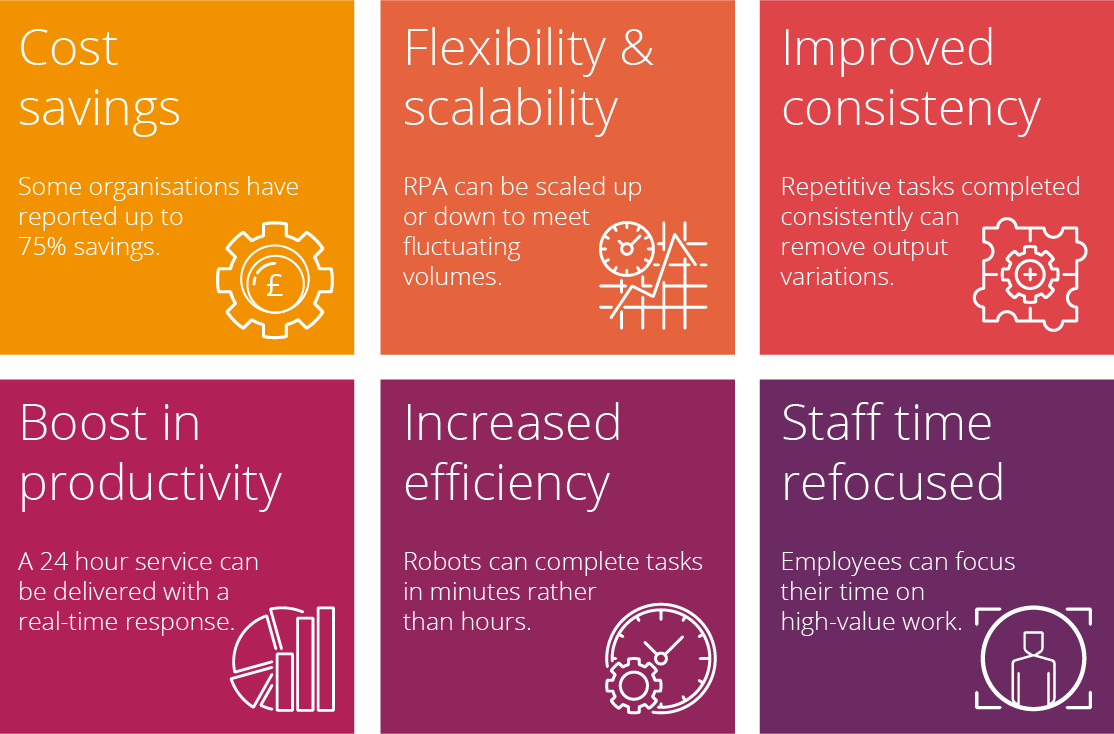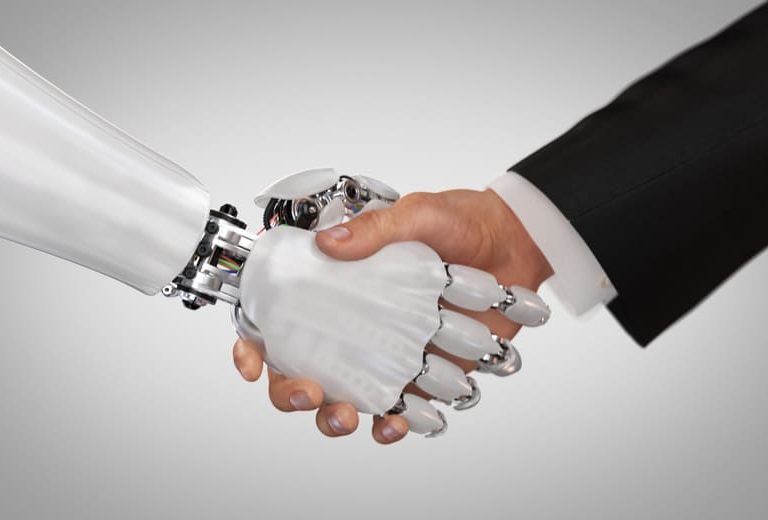Robotic Process Automation (RPA) is where software helps to automate traditionally repetitive, manual and labour-intensive back-office tasks.
RPA can create interconnected and interoperable organisations by combining physical and digital technologies to automate routine tasks. RPA is just one of the technologies many experts believe is influencing the 4th industrial revolution.
But what is Robotic Process Automation, and why should you embrace it?
This article will answer these questions.
Key takeaways:
- Learn what RPA is (and what it isn’t).
- Understand the benefits of Robotic Process Automation for your organisation.
- Understand how RPA can create an environment where the human and digital workforce can coexist.
- Help to think big but start small with manageable process automation projects you can build and expand.
- Choose an RPA vendor who has the ability to scale with you as your business needs change and technology evolves.
What is Robotic Process Automation?
Robotic Process Automation (RPA) is software or a set of tools that takes structured data and applies logical rules to complete routine tasks. It best suits repetitive, time-critical, error-prone, data-driven, and rules-based (predictable) processes.
For example, removing manual copy-and-paste data entry tasks.
According to leading analyst Gartner, the RPA software market grew 31% in 2021 and is expected to continue throughout 2023. Although at a slightly decelerated rate of 17.5% YoY, growth is set to continue as business demand increases.

Therefore, the Robotic Process Automation market is still the fastest-growing in the software industry, consistently outperforming other areas in the field.
What kind of processes can RPA automate?
Technology insight specialists, AI Multiple, found a typical rules-based process can be 70-80% automated by using RPA tools.
Robotic Processing Automation tools can automate entire workflows such as gathering, processing, updating or validating data.
Consider your organisation or department:
- What repetitive, labour-intensive, clerical tasks do your teams carry out?
- What data do they download, update and put into different systems?
- Do they merge, consolidate and output customer, supplier or employee information?
- What data do you need to track and monitor?
- And the big question is, how much time do your staff spend carrying out these tasks?
A typical rules-based process can be 70-80% automated by using RPA tools
Most of these repetitive tasks are core to how the business operates and need to happen. They are not often the core responsibilities of employees, however.
Key features of Robotic Process Automation
RPA can automate manual, repetitive tasks to add value to a team immediately.
Key features of RPA software include:
- RPA is not disruptive – you can automate processes without changing existing systems or structures.
- It’s user-friendly – staff do not need in-depth technical knowledge to run tasks.
- RPA can be scaled – you can upscale or downscale robotic operations in multiple business areas as you require.
- Data tools are inbuilt – you can collect, analyse, process data, and create reports.
- Security is high – RPA tools use role-based security management and encryption to protect data.
Who’s it for?
Think of RPA as a back-office processing centre but without human resources.
Tools can automate mundane, time-consuming tasks such as document automation, preventing teams from focusing on higher-value work.
For this reason, employees tend to welcome RPA projects because they benefit directly.

What Robotic Process Automation isn’t
Do you know the difference between robotic process automation and artificial intelligence?
You might hear different terminology to describe automation technology. Understanding the differences between automation and what is relevant can be confusing.
Artificial Intelligence (AI) gets mentioned frequently when giving robotic process automation examples. AI can learn, develop, interpret and analyse data, recognise patterns, and make predictions, suggestions and recommendations. Therefore, it is important to recognise the difference between AI and RPA.
RPA allows you to set rules and tell it what to do. Conversely, AI is ‘self-learning’; it will ‘think and learn’ and act on what it predicts as the correct solution.
Artificial Intelligence definitely has its place and is often discussed in articles as it displays the ‘intelligence’ of automation technologies. But, AI can be very disruptive.
AI is typically more expensive and can take longer to implement than RPA. It also requires you to understand a process in great detail and build complex scenarios for intelligent automation to work from.
Be aware of AI if you’re just starting the process automation journey. Instead, consider smaller automation projects you can implement in weeks, not years.
The main thing is not to get caught up in choosing the technology.
Instead, explore where the software can make the biggest impact in your organisation and department.
- Understand your current capabilities.
- Use the technology to deliver the best results without large capital costs and lengthy implementation times.
This is why RPA is the most attractive automation technology for most teams.
Six business benefits of Robotic Process Automation
Investments in software need to improve productivity, speed and accuracy whilst also reducing costs.
With the right automation tool, you could reduce millions of hours wasted on mundane, repetitive, labour-intensive tasks.
Here are the top six most rewarding benefits of using Robotic Process Automation tools.

- Cost reduction – Some organisations have reported savings of up to 75% through RPA. Many projects report higher savings than expected.
- Flexibility & scalability – Robotic Process Automation can accommodate fluctuating volumes and peak periods without needing extra resources. The technology can be scaled up or down as needed, so RPA can adapt to your business needs.
- Improved consistency and accuracy – Mistakes happen; we’re only human. Even the most conscientious employees make mistakes when completing repetitive and mundane tasks. However, small mistakes can cost businesses dearly.
- Staff time focused – People can be wary of RPA technology because of its impact on jobs. Robotic Process Automation should, however, work alongside your human employees. The software can enhance their core activities and allow more time for more creative or strategic tasks.
- Improved efficiency – Tasks that previously took hours by humans can now take seconds or minutes to complete by a robot, offering a competitive edge.
- Boost productivity – Robots do not eat, sleep, take holidays or phone in sick. Customers expect a real-time response and 24-hour service, which automation tools can help to deliver.
Limitations of RPA
RPA assists operations and can enhance how they are carried out. There are limitations, however.
Technology cannot fully replace humans but can lead to team reorganisation. Staff are free to work on other tasks, which adds value and may mean roles are changed. For this reason, some employees fear automation technology because of perceived job losses and other organisational changes. Therefore, adoption may take some time.
RPA technology only understands programming languages and rules-based logic, so it can lack human creativity.
Having said that, RPA is still driving efficiency improvements on the whole.
How to integrate RPA into your organisation
If you have thought, “why isn’t this automated?” then Robotic Process Automation could be the answer. Why not embrace it?
Introducing RPA to your organisation doesn’t mean you must change and automate all your business processes.
You will find many RPA vendors who offer all singing and dancing intelligent automation solutions. Realistically, these will take years to implement successfully.
Think big but start with baby steps…

Getting started with RPA implementation
Firstly, identify the role of RPA. Consider what RPA will mean for your organisation. Which processes would benefit from being automated? Where will it add value? What are your pain points?
Once you have a clear picture of how it could change how you operate, redefine the remaining roles humans will continue.
This will give you the big picture, help prepare, and reassure the workforce for future changes.
Pilot small automation projects first and then build up to implement them on a wider scale. In doing so, choose an agile, flexible vendor that can evolve with you.
Robotic Process Automation in use
Many RPA providers focus on automating the information that comes into your business. For example, taking a document, scanning it, analysing the content and inputting the information into one of your operating systems.
Automated inbound mail does bring benefits. However, the scope, content and layouts can be very broad. For this reason, the RPA tool you choose has to be able to cope with all those different formats.
Compare that with the automated outbound communications you send to customers, suppliers or employees, which probably come from a centralised system. You have great knowledge of the people and processes involved in the activity, so your automation project is much smaller.
Starting with RPA to automate outbound communications will demonstrate benefits in weeks rather than years.
Case study: Robotic process automation in HR
During Covid-19, like many organisations, the payroll team at the University of Salford needed to work from home. For this reason, it became impractical to print and seal paper payslips and P60s for their dispersed workforce.
Using Epay, the university launched a secure online payslip portal for staff to access past and present payroll documents in one secure place.
Consequently, automating the production and distribution of payslips and other payment documents is now a 100% paperless service.
Final thoughts
Understanding the difference between automation technologies can be complex.
Don’t ask, ‘how does robotic process automation work?’. Instead, estimate the value that it can add to your organisation.
Even a small project can garner huge efficiencies. Target the obvious opportunities and robotic process automation examples first.
Robotic Process Automation resources
If you’d like to learn more about how RPA could work for you, your teams and your organisation, head to the White Paper area on our website.
There are several resources available to download for free, including:
- Robotic Process Automation in Payroll
- The Future of Document Automation
- Guide: The Benefits of Business Automation
- Digital Transformation: it Starts With a Document
- Think Big, Start Small: Why It’s Time to Embrace Robotic Process Automation
Or, if you’d like to speak to one of our automation experts, please get in touch.


